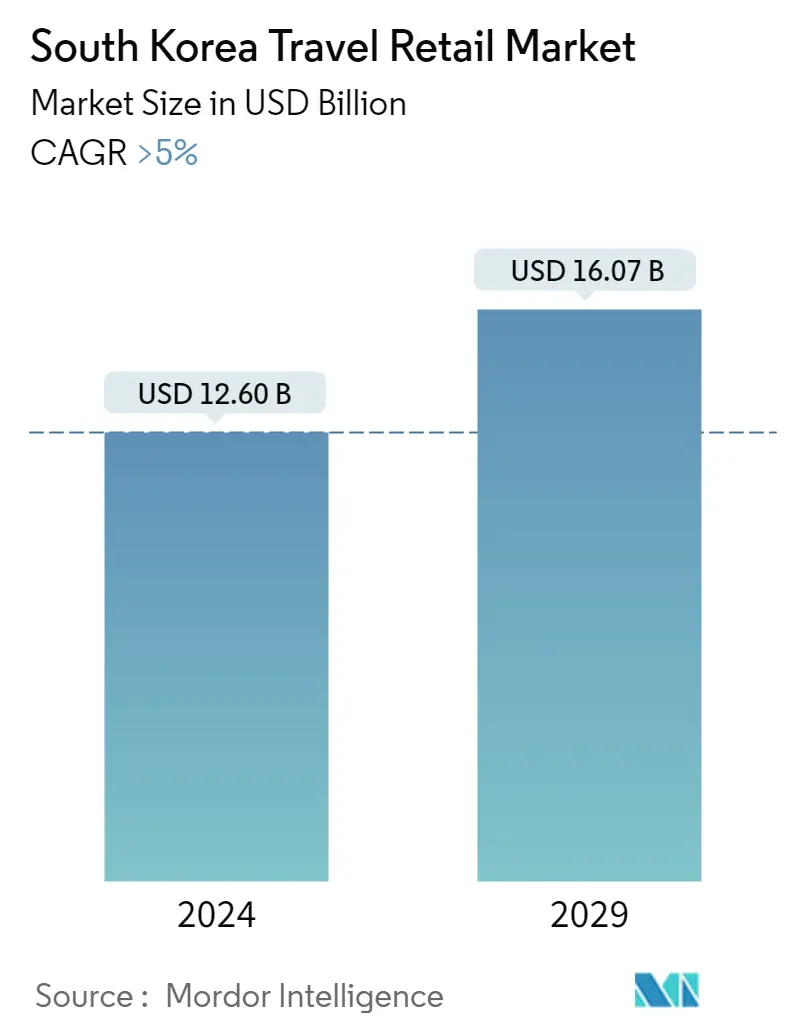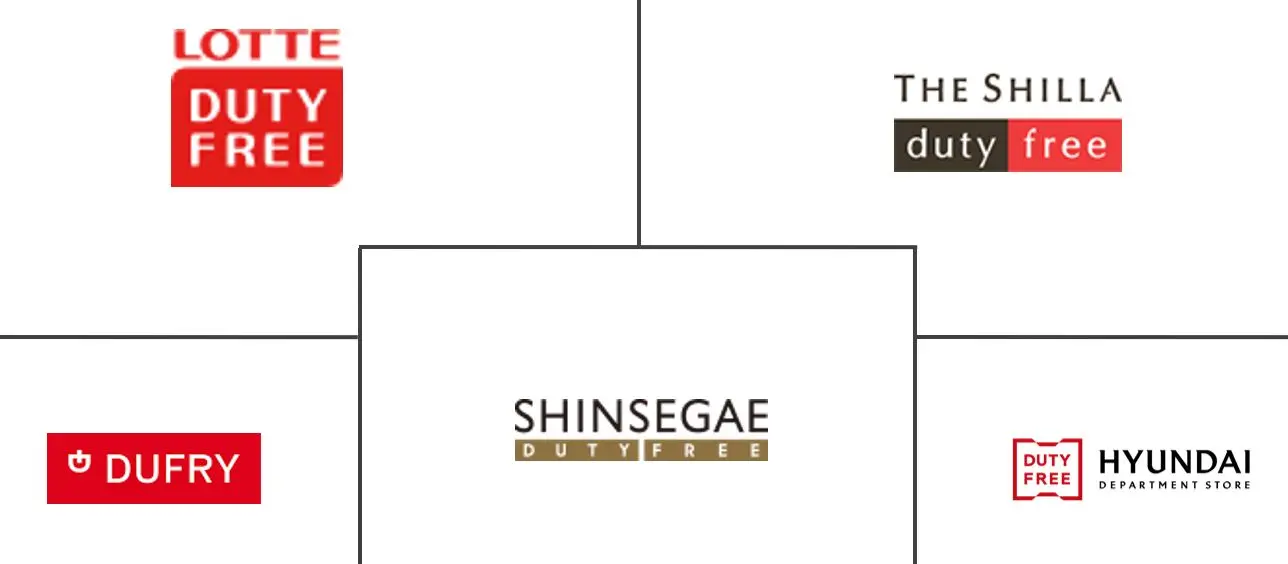Market Size of South Korea Travel Retail Industry

| Study Period | 2020 - 2029 |
| Base Year For Estimation | 2023 |
| Market Size (2024) | USD 12.60 Billion |
| Market Size (2029) | USD 16.07 Billion |
| CAGR (2024 - 2029) | 5.00 % |
| Market Concentration | High |
Major Players
*Disclaimer: Major Players sorted in no particular order |
South Korea Travel Retail Market Analysis
The South Korea Travel Retail Market size is estimated at USD 12.60 billion in 2024, and is expected to reach USD 16.07 billion by 2029, growing at a CAGR of greater than 5% during the forecast period (2024-2029).
Korea is one of the world’s largest duty-free markets, and its duty-free market benefits from the growth of Korean travelers, as well as increasing numbers of Chinese and Japanese travelers. With a strong downtown retail presence, Korea’s travel retail market is focused on beauty, cosmetics, and fashion products. While increasingly affluent Mainland Chinese travelers have boosted Korea’s duty-free market, Korean nationals are high spenders overseas and at Korean airports. The Korean duty-free market has unique competitiveness by entering various domestic and global brands represented by 'K-beauty' and Korea's unique culture and marketing capabilities. There has been an increase in downtown duty-free shops in South Korea. These shops allow travelers to purchase goods anytime during their trip instead of just before departure. Seoul has a significant number of downtown duty-free stores.
Luxury brands are increasingly important to the Asia-Pacific region’s travel retail market, reflecting the growing affluence of travelers. This is especially the case in already established duty-free markets such as Korea. For example, the new terminal at Incheon International Airport features the flagship stores of international luxury brands such as Chanel, Dior, Sulwhasoo, Lancome, SK2, and Estee Lauder84. It also includes renowned liquor and tobacco brands such as Ballantyne's, Johnnie Walker, Royal Salute, Hennessy, KT&G, and IQOS. The post-COVID scenario of the South Korea travel retail market is gradually improving. With the easing of travel restrictions and the resumption of international tourism, there is a growing demand for duty-free shopping and travel-related products. The market is adapting to the new normal by implementing safety measures and offering attractive promotions to attract travelers.
South Korea Travel Retail Industry Segmentation
Travel Retail is commonly used to describe the duty-free retail industry and all retail activities dedicated to travelers and tourists. A complete background analysis of the market, including the estimation of market size and forecast, market shares, industry trends, growth drivers, and vendors, is provided. The study also includes insights into market segmentation by product type and distribution channel. Additionally, the report features qualitative and quantitative assessments by analyzing the data gathered from industry analysts and market participants across key points in the industry’s value chain.
The Market is segmented by product type (beauty and personal care, wines and spirits, tobacco, eatables, fashion accessories and hard luxury, and other types), by distribution channel (airports, airlines, ferries, and other distribution channels).
The report offers market size and forecasts for the South Korea travel retail market in terms of value (USD) for all the above segments.
| Product Type | |
| Beauty and Personal Care | |
| Wines and Spirits | |
| Tobacco | |
| Eatables | |
| Fashion Accessories and Hard Luxury | |
| Other Types |
| Distribution Channel | |
| Airports | |
| Airlines | |
| Ferries | |
| Other Channels |
South Korea Travel Retail Market Size Summary
The South Korea travel retail market is a significant player in the global duty-free industry, benefiting from the influx of both domestic and international travelers, particularly from China and Japan. The market is characterized by a strong focus on beauty, cosmetics, and fashion products, with Korean brands like 'K-beauty' gaining international recognition. The presence of downtown duty-free shops allows travelers to shop conveniently throughout their stay, enhancing the overall shopping experience. Luxury brands are increasingly prominent, with flagship stores in major airports like Incheon, reflecting the growing affluence of travelers. The market is gradually recovering from the post-COVID scenario, with the easing of travel restrictions and the resumption of international tourism driving demand for duty-free shopping.
The growth of South Korea's travel retail market is fueled by improved living standards, increased disposable income, and a burgeoning tourism industry. Young, urban consumers are particularly driving trends, seeking new travel experiences and digital shopping solutions. The market is highly fragmented, with major players like Lotte Duty Free, The Shilla Duty Free, and Shinsegae Duty Free dominating, while mid-size and smaller companies are expanding their presence through technological advancements and product innovations. South Korea's unique beauty culture and the constant demand for new beauty trends make it an attractive market for global beauty brands, which often choose duty-free channels for their entry into Asia.
South Korea Travel Retail Market Size - Table of Contents
-
1. MARKET INSIGHTS AND DYNAMICS
-
1.1 Market Overview
-
1.2 Market Drivers
-
1.2.1 Beauty Products, Jewellery, Fashion and Accessories are Faster Developing Segments in the Market
-
-
1.3 Market Restraints
-
1.3.1 Rising Fuel Prices Impacting Travel Costs
-
-
1.4 Market Opportunities
-
1.4.1 Collaborating with Airlines and Travel Agencies to Create Exclusive Retail Experiences
-
-
1.5 Industry Value Chain Analysis
-
1.6 Porter's Five Forces Analysis
-
1.6.1 Bargaining Power of Suppliers
-
1.6.2 Bargaining Power of Buyers/Consumers
-
1.6.3 Threat of New Entrants
-
1.6.4 Threat of Substitute Products
-
1.6.5 Intensity of Competitive Rivalry
-
-
1.7 Impact of COVID-19 on the Market
-
-
2. MARKET SEGMENTATION
-
2.1 Product Type
-
2.1.1 Beauty and Personal Care
-
2.1.2 Wines and Spirits
-
2.1.3 Tobacco
-
2.1.4 Eatables
-
2.1.5 Fashion Accessories and Hard Luxury
-
2.1.6 Other Types
-
-
2.2 Distribution Channel
-
2.2.1 Airports
-
2.2.2 Airlines
-
2.2.3 Ferries
-
2.2.4 Other Channels
-
-
South Korea Travel Retail Market Size FAQs
How big is the South Korea Travel Retail Market?
The South Korea Travel Retail Market size is expected to reach USD 12.60 billion in 2024 and grow at a CAGR of greater than 5% to reach USD 16.07 billion by 2029.
What is the current South Korea Travel Retail Market size?
In 2024, the South Korea Travel Retail Market size is expected to reach USD 12.60 billion.

